|
March 4, 2017 - No. 7
In
Memoriam
Wendell
Fields

August 26, 1957 - March 1, 2017
|
|
• Presentation
to
Standing
Committee
of
the
Ontario
Legislature
on Justice and
Social Policy, 1999
• In Defence of the Right to
Conscience
- Regina v. Fields, 1986 -
All Out for March 8
International Women's Day
• Calendar of Events
Necessity for New
Direction for the Economy
• Approval of Keystone XL Pipeline
• Looking at the Hype About
Pipelines
- Peggy Morton -
• Alberta's Petrochemical
Diversification Program
- K.C. Adams -
• Quebec People's Legitimate Concern over
Fracking
- Fernand Deschamps -
Neo-Liberal Reforms to
Canada Transportation Act
• Workers Demonstrate Against
Deregulation and Privatization
• Nation-Wrecking Reform of
Canada's Transportation System
- Workers' Centre of CPC(M-L) -
In Memoriam
Wendell Fields
 With profound sorrow the
Communist Party of Canada
(Marxist-Leninist) informs you that our Comrade Wendell Fields
died on the afternoon of March 1 at 1:55 pm. Wendell learned of
his cancer a little more than two short months ago. Despite its
severity, he never flinched; he marched on. Five short weeks ago,
on January 21, despite his illness and pain, he joined the
marches of millions of people in the United States, Canada and
other countries following the inauguration of the new U.S.
President. He wrote a sign calling for the defence of women's
rights and the rights of all and to Renew the Resistance! Renew
Canada! With profound sorrow the
Communist Party of Canada
(Marxist-Leninist) informs you that our Comrade Wendell Fields
died on the afternoon of March 1 at 1:55 pm. Wendell learned of
his cancer a little more than two short months ago. Despite its
severity, he never flinched; he marched on. Five short weeks ago,
on January 21, despite his illness and pain, he joined the
marches of millions of people in the United States, Canada and
other countries following the inauguration of the new U.S.
President. He wrote a sign calling for the defence of women's
rights and the rights of all and to Renew the Resistance! Renew
Canada!
We express our deepest sympathies to Wendell's comrades
and
friends and his brothers, sisters and other family members. We
all take solace in knowing that their loving care and attention
permitted Wendell to leave us knowing how profoundly he was
appreciated and the social love and affection he inspired in so
many.
Wendell was born in Windsor, Nova Scotia, on August 26,
1957. When Wendell was 10 years old, his father Corporal Hugh Fields
and six other paratroopers based in Canadian Forces Base Petawawa were
killed in a night-time training exercise when a sudden change in winds
blew them off course, and they fell into the Ottawa River and drowned.
This tragedy was to cause the
family great hardships in the following years as Wendell's mother
Eileen struggled to look after herself and her five young
children. From an early age, Wendell took responsibility to
contribute to the family's well-being, working the kind of
low-paying jobs typically open to young people. From this
experience, he formed a consciousness of the problems arising
from the relationship between the society and its members and
their well-being and the question of social responsibility.
Politics was to become a defining part of Wendell's life.
Wendell became involved in the work of the Party as a
young
man when he and his family were living in Cambridge, Ontario in
the 1970s. He was listening to the University of Waterloo campus
radio station and heard about the Anti-Imperialist Alliance, the
youth and student branch of CPC(M-L). He was immediately drawn to
the work of the Party to organize the workers to oppose the
shifting of the burden of the economic crisis onto their backs --
the struggle at the time to Make the Rich Pay, which later became
focused on the struggle to stop governments from paying the rich
at the expense of the peoples' well-being.
Wendell joined in the unfolding struggle at the
university
over the student newspaper, the Chevron in 1977. Students
rallied to defend freedom of the press when the student council
shut the paper down because it disagreed with the student press
being open to all political views and opinions, including those
guided by Marxist-Leninist theory.
After Wendell joined the Anti-Imperialist Alliance as a
community youth activist, he went on to participate in the
struggles against state-organized racist and fascist attacks,
such as the opposition to the formation of the Tactical Swat
Squad in Kitchener-Waterloo, and the harassment and persecution
of CPC(M-L). He was amongst those who contributed to the defeat
of the state's attempt to frame Comrade Hardial Bains on the
trumped up charge of "aiding and abetting an illegal immigrant"
after the political police raided a party research centre in
Kitchener-Waterloo. He became a member of the Party in 1979.
Wendell worked as a moulder in a plastics factory in
Cambridge in the early eighties and never missed an opportunity
to stand in solidarity with other workers fighting for their
rights. In 1984, while supporting striking workers at a Canada
Trust branch office in Cambridge, he was arrested and charged
with "assaulting police" when the police violently attacked the
picketers to enable cars to cross their picket line. Wendell
initiated a criminal charge of assault against a police officer
who had injured him in the arrest. During his testimony as a
witness at the officer's trial, Wendell was questioned about his
membership in CPC(M-L). When he refused to answer on the ground
that it was irrelevant to the fact that he had been assaulted,
the judge demanded he answer the question or be jailed for
contempt. Still Wendell refused whereupon the judge cited him for
contempt of court and jailed him. Wendell appealed the verdict
and was vindicated when the Ontario Court of Appeal decided that
he had rightfully refused to answer and that his contempt
conviction should be overturned. This decision set two precedents
and was written up in Martin's Criminal Code.
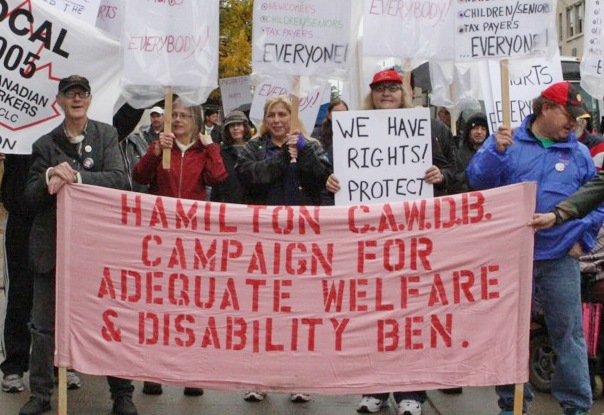 In 1987, after being laid
off from his job in Cambridge,
Wendell moved to Hamilton, which became his home. In his new
location he contributed to the work of the non-Party mass press
helping to establish and distribute New Hamilton Weekly.
Besides constant work of the Party, Wendell also became active in
Hamilton Against Poverty (HAP), which he participated in
thereafter. With other HAP members, Wendell organized opposition
to the Harris government's anti-social offensive. He and his
comrades never stopped their resistance, as succeeding
governments at all levels have continued the anti-social
offensive with a vengeance. In 1987, after being laid
off from his job in Cambridge,
Wendell moved to Hamilton, which became his home. In his new
location he contributed to the work of the non-Party mass press
helping to establish and distribute New Hamilton Weekly.
Besides constant work of the Party, Wendell also became active in
Hamilton Against Poverty (HAP), which he participated in
thereafter. With other HAP members, Wendell organized opposition
to the Harris government's anti-social offensive. He and his
comrades never stopped their resistance, as succeeding
governments at all levels have continued the anti-social
offensive with a vengeance.
Wendell waged an informed ideological offensive against
the
legislation of the anti-social offensive, exposing the
retrogressive direction that was destroying the very conception
of a modern society and its responsibility towards its members.
He fought to elaborate a pro-social program in the face of the
attacks on the rights of the workers and the most vulnerable
sections of society. Wendell lived by the mottos that Our
Security Lies in the Defence of the Rights of All and that No
Means No! He refused to go along with the
marginalization of any section of the people, be it on the basis
of their political beliefs, race, national origin, gender,
religious beliefs, social status or ability.
Wendell also stood with the Six Nations of the Grand
River Territory against
the illegal encroachment of their lands at Caledonia and
participated in the struggles of the disabled for their rights
and dignity, as well as in many other battles.
Wendell was a candidate of the Marxist-Leninist Party
of
Canada in the 1997, 2000, 2011 and 2015 federal elections and
highlighted the need for the people to fight for their political
empowerment. In his statement made on cable TV to the people of
Hamilton during the 2015 federal election, he pointed out among
other things:
"For all the working people of the Hamilton area, for
the
many thousands of retirees and for the good of the entire
community -- we need to recognize the need for political renewal
so that we can empower Canadians and not have political parties
form governments which reduce citizens and residents to
spectators of decisions taken in the boardrooms and corridors and
back alleys. We need a new direction for the economy that is set
by and for the people in which they have the decision-making
authority to halt the destruction of everything they have
built."
He also ran as an independent candidate in the 1999
Ontario
elections and was a mayoral candidate in Hamilton for the 1997
municipal elections calling for mechanisms to be brought into
being so that Hamiltonians could exercise political decision-making
power over the affairs of their city.
As an activist in Hamilton, Wendell stood with
steelworkers
from the first day of their epic fight against the legalized
theft under the CCAA perpetrated by Stelco in 2004. Rolf
Gerstenberger, President of the Marxist-Leninist Party of Canada
and former President of USW Local 1005, recalls:
"Wendell moved to Hamilton around 1987 when the New
Hamilton Weekly was started. He volunteered to help with the
distribution, helping to deliver New Hamilton Weekly to stores
and
apartment buildings. In those days we printed 140,000 copies paid
for with advertisements and distributed for free so it was no
small feat to distribute them in a timely manner. Our project
would not have succeeded without Canada's unsung heroes like
Wendell.
"Wendell was an avid reader of political literature and
an
active participant in the Party's programs and never hesitated to
volunteer for various projects. He fought all his life to affirm
the rights of all by virtue of being human, and it was a rare
demonstration in Hamilton that Wendell did not participate in. He
was active in the anti-war movement and in opposing the U.S.
imperialist domination of Canada. He was one of the stalwarts in
Hamilton fighting for the rights of the most impoverished. And of
course the steelworkers knew Wendell for he attended all their
rallies, demonstrations and events."
All those who knew Wendell and worked with him will
forever
treasure his uncompromising fidelity to his principles, his
revolutionary communist spirit, as well as his warmth and
comradeship. When Wendell was undergoing medical treatment, one
of the staff asked him, "What would you like to do more than
anything else?" Without hesitation Wendell answered, "I want to
overthrow this man-eating system and build a society fit for
human beings." This was the spirit that characterized Wendell
throughout his life as a communist fighter for the rights of all
and for the new world being born.
In a letter to Wendell shortly before he died, the
First
Secretary of the Central Committee of CPC(M-L) wrote:
Dearest Wendell;
On behalf of the entire Party I send you our most
profound
revolutionary communist greetings, social love and appreciation
for your contribution to building the New in Canada and the fight
for peace and justice internationally as well.
One of the things that always stands out for me is your
steadfast refusal to permit the most important concerns of the
people to be marginalized or dismissed. You did this by putting
your own self on the line time and time again -- standing up to
the cowardly powers that be as they paraded as democratic and
humanitarian and tried to present those like you, who fight to
humanize the social and natural environment, as extremist, fringe
and dispensable.
Dear Wendell. Never ever under your watch has that ever
succeeded. You addressed public consultations and meetings. You
ran for parliament as a worker politician. You joined forces to
build the technical base of the Party and non-Party press. You
stood with the Party and modern communism through thick and thin.
You even set two legal precedents in defence of the rights of
all, especially the right to conscience. You have made us so
proud time and time again.
The spirit of modern communism has your name on it,
Wendell
Fields. It is an inspiration like no other.
Ever Yours

Presentation to Standing Committee of the Ontario
Legislature
on Justice and Social Policy, 1999
Comrade Wendell Fields actively participated in the
struggle of the working class and youth of Ontario against the
anti-social offensive of the Harris Conservative government. As
the "common-sense revolution" of Premier Mike Harris unfolded,
attacking the rights and well-being of the workers and
particularly targeting the most vulnerable with its cuts to
social funding and criminalization of the poor, Wendell was
unflinching in his conviction that society is duty-bound to take
care of its members by recognizing and affirming the rights of
all. As part of this work, during the period of Harris' second
majority government, Wendell appeared on November 29, 1999 before
the Standing Committee of the Ontario Legislature on Justice and
Social Policy along with two other members of Hamilton Against Poverty
to
speak out against Bill 8, the "Safe Streets Act, 1999." The full text
of Wendell's intervention follows.
***
My name is Wendell Fields. I'm a member of Hamilton
Against
Poverty.
For over a year now the government and monopoly media
have
been engaged in a well-financed campaign of misinformation and
fear-mongering about the youth, the poor and squeegee kids being
a safety hazard. Once a climate of fear has been established,
it's used to justify putting in tough legislation as the solution
to criminalize the poor and the youth.
Why did the government not consider that they were
creating a
hazard to Ontario society and people when they cut or reduced
social programs, when they cut or reduced health care, when they
cut or reduced education?
Squeegeeing and panhandling are one result of these
measures.
It's a problem of society. The "bad behaviour" of panhandlers and
squeegee kids is promoted to ensure that the substantive issues
are not raised. Why there's a need for squeegeeing or panhandling
to make a living for oneself is not addressed, nor is it even a
consideration of those who draft this legislation. What the
problems facing squeegee kids and panhandlers are is not
considered. It doesn't occur to some people to investigate and
address this. Why do people beg? Why do people squeegee? Why does
Ontario society not take all human beings and their well-being
into account? Why is the sole concern of the Ontario government
to make monopolies competitive on the global market? Why does
this government not recognize that it has a social responsibility
to all the members of Ontario society?
 This government represents
a certain type of society which
refuses to recognize that the people of Ontario have the right to
a livelihood, the right to a free, quality education, the right
to 24-hour recreational centres, the right to their own social
consciences. In the 19th century, with the logic of the
criminologists and social workers in Canada, it was promoted that
aggression appears to be an innate human impulse. Poor families
were not guaranteed food, shelter, education or income support,
which led to malnutrition and starvation. Under such conditions,
the youths were forced to steal food and other household
necessities in order to biologically survive and to sustain
themselves and their families. This government represents
a certain type of society which
refuses to recognize that the people of Ontario have the right to
a livelihood, the right to a free, quality education, the right
to 24-hour recreational centres, the right to their own social
consciences. In the 19th century, with the logic of the
criminologists and social workers in Canada, it was promoted that
aggression appears to be an innate human impulse. Poor families
were not guaranteed food, shelter, education or income support,
which led to malnutrition and starvation. Under such conditions,
the youths were forced to steal food and other household
necessities in order to biologically survive and to sustain
themselves and their families.
Today, when the government's role is to do everything
to
ensure corporations' maximum return on their investment dollar in
the global market, it is abandoning the Ontario people to
destitution by removing funds from health, education and social
programs. This is also done in the name of having a strong
economy, one in which the provincial debt has increased almost
two times, from $39 billion in 1989 to $105 billion. There's your
strong economy.
When the youth try to survive by offering a service for
a
voluntary donation -- a tip, if you will -- by cleaning car windows, a
service once done by gas station attendants, they do so out of
necessity because Ontario society is not organized in a manner
which guarantees that their needs are met.
What do the youth and poor have? What is the level of
education they're receiving? Do they have access to recreational
facilities? Do they have food? Do they have shelter? Do they have
warm clothing? Does the government, when drafting legislation,
take these factors into consideration?
There are very real social, economic and political
problems
facing Ontario society and this arbitrary legislation to force
the youth to toe the line, shut up and accept their lot in life
will not solve these problems, and pretending these problems of
society don't exist won't wash either.
Unemployment and destitution face youth daily. In an
attempt
to solve this problem with some squeegeeing, they try to solve a
social problem facing them. For this they're held in contempt,
criminalized and attacked. The fact of it is that the youth do
have the right to think, to organize and to have a livelihood
despite the attacks they face from this old society.
Squeegeeing is actually working for some money, trying
to
survive. For this the youth are criminalized. When conditions
exist where their rights as human beings or the collective rights
of youths are denied, certain things occur. When their rights to
a livelihood, shelter, education and so on are violated, they
will aggressively demand and affirm that society has a social
duty, a social responsibility to guarantee their needs to live as
human beings. They will organize themselves into squeegee squads
and work for some money to buy food, and establish their own work
rules. There is nothing wrong with the behaviour of the youth.
They are simply demanding to live. They are not the
troublemakers.
 This legislation seeks to create an
atmosphere where the
youth question nothing, where they don't think for themselves,
where they consider themselves criminals and have no bright
future. It is the spirit of the youth to have their own
conscience, their own thinking, and to be exuberant, rebellious,
to have a spirit of resistance and rebelliousness against the
status quo. This is a factor, this is a symptom of being
youthful, and this cannot be quashed by this legislation. This legislation seeks to create an
atmosphere where the
youth question nothing, where they don't think for themselves,
where they consider themselves criminals and have no bright
future. It is the spirit of the youth to have their own
conscience, their own thinking, and to be exuberant, rebellious,
to have a spirit of resistance and rebelliousness against the
status quo. This is a factor, this is a symptom of being
youthful, and this cannot be quashed by this legislation.
To hide the fact that this old Ontario society is
unable to
sort out any problems facing society, there are those who seek to
create a diversion. Small businesses face economic difficulty.
Big businesses like Eaton's go under and are gobbled up by the
competitors. The economy cannot provide for everyone. Only the
rich and the debt payments are considered.
An economy which has not and cannot provide and
guarantee
human rights for the people is not a strong economy. What sort of
strong economy creates a destitute people? To divert from this,
beggars and squeegee kids are set up as being the problem. They
are attacked and scapegoated. Their problem is this old society
and its economic system. When the squeegee kids and others in
society organize themselves to defend their rights, they're
considered a problem, a concern for the rich corporations, banks,
a concern of this government.
Cleaning the streets of beggars and squeegee kids and
those
who fight for their rights does not show the warmth of the
Ontario people. Squeegee kids and beggars are marketing for
tourists and tourist dollars just what type of great province
Ontario actually is. They show to a monied tourist just what kind
of strong economy Ontario has. Squeegee kids and beggars show
what the natural destination for people is once health, education
and social programs are cut, reduced and eliminated. Hiding this
won't heal this festering wound of decay.
When legislation is imposed on the youth and the poor
without
the beggars' and squeegee kids' participation, in the name of
"for their own good" or "for the good of society," then such
rules will not be respected nor will such rules be defended. The
youths' spirit of resistance will be inspired and this is what
will get them through the coming desperate straits.
They will take the responsibility to organize
themselves in
order to fight for a society to recognize and guarantee their
needs and rights, and for a society to meet these claims made
upon it. These are the real people, these are the real heroes of
Ontario and of Canada, these are the people to which a democratic
society will listen.
Just on a question of democracy, a fundamental,
democratic
principle is that 50 per cent plus one of a vote is a majority.
There is no political party in power on the basis of near this
number of votes. The present Ontario government is in power with
less than 25 per cent of the eligible voters' vote. It really
doesn't have any legitimate democratic right to govern us.

In Defence of the Right to Conscience
- Regina v. Fields, 1986 -
Wendell Fields dedicated his life to defending the
rights
of the working people and even joined the Party in 1979 as part
of a battle waged by the youth at that time in defence of freedom
of speech and expression.
One of his greatest causes was to defend the right to
conscience. The courage with which he did so became clear in 1984
when he stood up to the badgering of a judge of the Ontario Court
who threatened him again and again that if he did not answer a
question about his political affiliation he would be found in
contempt of court and jailed. Wendell was jailed for 30 days -- a
sentence which was later overturned on appeal.
Wendell refused to answer the question on grounds that
it was irrelevant to the case, in which a police officer was charged
with assaulting him during a strike in July 1984. The defence
lawyer for the police tried to insinuate that Wendell's beliefs
somehow justified the police assault against him and insinuate
that he belongs to a criminal organization.
This is exactly what is being done today to criminalize
all
the forces across the country who want problems of the economy,
environment, nation-building, resource extraction, social and
political policy and war and peace discussed publicly. The state
finances so-called right wing extremists to spew hate and commit
violent acts. It then blames those who defend the cause of
justice and rights, accusing them of also engaging in hate
crimes, all to outlaw the right of all members of the polity to
speak or defend just causes.
Wendell won his case in 1986 on appeal and the case Regina
v.
Fields set two legal precedents. TML Weekly is
publishing extracts from the transcript in which the defence
attorney and then the judge asks Wendell over and over to state
whether he is a member of the Marxist-Leninist Party and Wendell
refuses -- a great courtroom defence of freedom of conscience and
defiance of injustice.
***
Defence: Mr. Fields, on the date in
question
you were not a member of this particular Union that was striking,
were you?
Wendell Fields: No, I am a Union
sympathiser.
D: No, just answer my
question, I
said you were not a member of that Union?
WF: No.
D: All right, and as a matter of
fact you
are not a member of any Union?
WF: No, that is correct.
D: Right, you are a member, however,
of the
Marxist-Leninist Party?
WF: Ahhh, I am not going to answer
that.
D: Well I am asking you.
WF: My political beliefs is not the
issue
here.
D: Your Honour, I ask for an
answer to
that.
Judge: Yes, you have to
answer the
question.
WF: And if I refuse?
Judge: And if you refuse you may be
held in
contempt of court.
D: I undertake to you that it
is relevant,
sir?
Judge: Yes.
WF: I'm going to refuse to
answer the
question.
D: All right, I will finish with my
other
questions and then perhaps you can get some legal advice and
answer that question in due course.
WF: If I was an NDP member
would you ask
what my political affiliation was?
D: I don't care about your
political
affiliation, I asked you if you were a member of the
Marxist-Leninist Party?
WF: Well the question was
geared to it.
D: I asked you specifically if you
are a
member of an outfit called the Marxist-Leninist Party?
WF: Well what my political
affiliation is
doesn't matter.
D: I don't care about
politics.
WF: Well obviously the
question shows that
you do.
D: I am asking you if you are
a member of
that group? I am suggesting that it is the same if I ask you if
you are a member of a motorcycle gang?
WF: I can't answer that
question.
D: You won't answer?
WF: NO.
D: Okay, all right, now you
... let's get
back to the question that I asked you earlier, and I do want an
answer because it is important. Are you a member of a group
called the Marxist-Leninist Party?
WF: I am going to refuse to
answer that.
D: But His Honour has
instructed you to
answer?
A: Yes, I know that, yes.
D: Your Honour I want an
answer to that
question because it is relevant in this sense in terms of what
the whole purpose is of these proceedings and by that I mean the
charges and so on and I want an answer to that question.
Judge: You are refusing to
answer?
WF: Yes, I am.
Judge: Yes, well I am going
to cite you for
contempt and I will give you an opportunity to present a defence
to that charge, do you understand me?
WF: Yes.
To read the full decision in Regina v. Fields, click
here.

All Out for March 8 International Women's
Day
Calendar of Events
The Communist Party of Canada (Marxist-Leninist) calls
on
Canadians to go all out to make March 8 International Women's Day
2017 a success.
This year, International Women's Day is taking place at
a time of heightened consciousness of the need to renew the resistance.
Millions have taken part in demonstrations to reject government of
police powers represented by the new Trump administration as well as
repudiate the misogyny, racism and aggression espoused by the U.S. and
other big powers, some in the name of progressive values. Many are also
becoming conscious of the need for political movements in defence of
rights and against war. How to identify and overcome what is blocking
the fight for women's rights and contribute to the emancipation of all
working people is on everyone's minds. One conclusion increasingly
drawn is that the existing institutions the people are saddled with are
anachronistic.
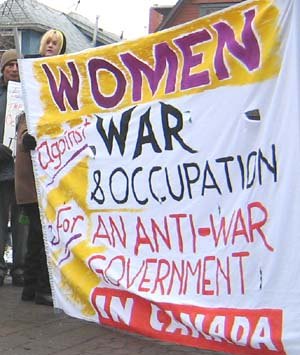 One hundred and six years ago, the
first International Women's Day was celebrated to focus on the call for
peace issued by women in Europe prior to World War I. International
Women's Day is in fact from its beginning imbued with the spirit of
proletarian internationalism because it is centred on the striving of
women for their emancipation in the context of the emancipation of the
entire working class and oppressed peoples. Women have always stood in
the forefront of the struggle for rights, peace, and the progress of
society. This shows that the question of women's fight to affirm their
own rights is inseparable from the issue of political power and the
fight of the working people to exercise leadership over the society,
build their own institutions and put an end to exploitation, oppression
and war. One hundred and six years ago, the
first International Women's Day was celebrated to focus on the call for
peace issued by women in Europe prior to World War I. International
Women's Day is in fact from its beginning imbued with the spirit of
proletarian internationalism because it is centred on the striving of
women for their emancipation in the context of the emancipation of the
entire working class and oppressed peoples. Women have always stood in
the forefront of the struggle for rights, peace, and the progress of
society. This shows that the question of women's fight to affirm their
own rights is inseparable from the issue of political power and the
fight of the working people to exercise leadership over the society,
build their own institutions and put an end to exploitation, oppression
and war.
TML Weekly is publishing a calendar (link
above)
of
International Women's Day celebrations, gatherings and rallies
across the country beginning on Saturday, March 4. CPC(M-L)
encourages everyone to participate and join in the work to defend
the rights of women and the rights of all.

Necessity for New Direction for the
Economy
Approval of Keystone XL Pipeline

Protest against construction of Keystone XL pipeline, Washington, DC,
November 6, 2011.
(TSA Clayton)
U.S. President Donald Trump issued executive orders
pushing the Keystone XL and Dakota Access pipelines on January
24. The presidential order on Keystone XL invited TransCanada
Pipelines to reapply for its cross-border permit and directs the
U.S. State Department to "take all actions necessary and
appropriate to facilitate its expeditious review." The order
gives the State Department 60 days from receipt of TransCanada's
new application to issue a final decision.
TransCanada Pipelines announced two days later that it
had
filed a presidential permit application seeking approval for the
Keystone XL pipeline. The pipeline will ship dilbit (bitumen plus
diluents added so the oil will flow down the pipeline) to
refineries on the U.S. Gulf Coast. The presidential order does
not mention any conditions Trump would negotiate and impose other
than building the line with steel made in the United States.
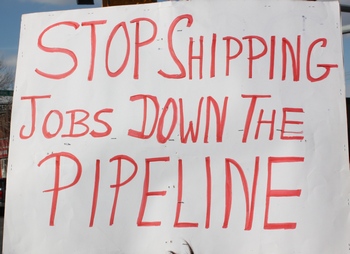 In response to this
development, Prime Minister Trudeau
boasted during a federal cabinet retreat in Calgary: "I've been
on the record for many years supporting [Keystone XL] because it
leads to economic growth and good jobs for Albertans." Trudeau's
remarks seemed intended to convey the impression that Trump's
reversal of President Obama's opposition arose in part from
Trudeau's insistence the pipeline be built. It appeared to many
as a desperate attempt to reverse the image of a man who
callously said an unemployed energy worker in Edmonton did not
deserve full unemployment insurance benefits because the city's
rate of unemployment did not warrant it. In response to this
development, Prime Minister Trudeau
boasted during a federal cabinet retreat in Calgary: "I've been
on the record for many years supporting [Keystone XL] because it
leads to economic growth and good jobs for Albertans." Trudeau's
remarks seemed intended to convey the impression that Trump's
reversal of President Obama's opposition arose in part from
Trudeau's insistence the pipeline be built. It appeared to many
as a desperate attempt to reverse the image of a man who
callously said an unemployed energy worker in Edmonton did not
deserve full unemployment insurance benefits because the city's
rate of unemployment did not warrant it.
Regardless of Trudeau's subjective motives, how about
the
substance of the remark that building pipelines "leads to
economic growth and good jobs for Albertans." Keystone and
Keystone XL were opposed by organized energy workers, the Alberta
Federation of Labour and many other organizations because they
ship jobs down the pipeline through the export of unprocessed
oil. The opposition to the pipeline reflects a growing public
opinion that the extraction and sale of natural resources must be
tied to a strict ratio of investments in regional and national
basic industries, manufacturing, social programs and public
services. A consciousness is developing that Canada and its
regions need a new economic direction, one that develops a
diverse economy that retains the bulk of its earnings from
exports and ploughs them back in exchange and investment for
extended reproduction. This would develop a broad internal
regional economy that could stand on its own and provide security
from the boom and bust cycles of today within the imperialist
system of states. Canada needs a nation-building project that
restricts the financial oligarchy from taking the new value
workers create out of the regional and national economy. Without
such a direction Canadians remain vulnerable to recurring
economic crises.
The energy oligopolies and their political
representatives
through their control have put the economy in a straitjacket of
dependence on oil and other natural resource exports, their
global market prices and uncertain demand. The earnings from
exports are mostly taken out of the regional economy or invested
back into producing and shipping out more of the same natural
resource. More of the same is epitomized in building more
pipelines. But the constantly repeated mantra that pipelines
"lead to economic growth and good jobs" does not survive a closer
look.
 The capacity of pipelines
approved or under review exceeds
anticipated production to fill them. Together, Keystone XL, the
recently approved Trans Mountain and the Enbridge Line 3
replacement would increase pipeline capacity by about 1.8 million
barrels per day (b/d). The Energy East project would add another
1.1 million b/d, for a total of 2.9 million b/d. This contrasts
with the oil industry's estimate that oilsands production will
grow by between 850,000 and one million b/d by 2025, which in
turn is based on oil prices rising or at least remaining at
current levels. But production levels are bound to increase in
the U.S. shale fields of the Bakken Formation (North Dakota) and
the Permian Basin in west Texas where vast amounts of oil are
available through fracking and profitable even at today's market
prices. Also, Trump is escalating Obama's policy of encouraging
U.S. oil production. The capacity of pipelines
approved or under review exceeds
anticipated production to fill them. Together, Keystone XL, the
recently approved Trans Mountain and the Enbridge Line 3
replacement would increase pipeline capacity by about 1.8 million
barrels per day (b/d). The Energy East project would add another
1.1 million b/d, for a total of 2.9 million b/d. This contrasts
with the oil industry's estimate that oilsands production will
grow by between 850,000 and one million b/d by 2025, which in
turn is based on oil prices rising or at least remaining at
current levels. But production levels are bound to increase in
the U.S. shale fields of the Bakken Formation (North Dakota) and
the Permian Basin in west Texas where vast amounts of oil are
available through fracking and profitable even at today's market
prices. Also, Trump is escalating Obama's policy of encouraging
U.S. oil production.
Western Canada currently produces about 3.7 million b/d
of
oil transported to market by pipeline or rail. Three oilsands
projects will come on stream in 2017 -- Canadian Natural
Resources Ltd. (CNRL)'s Phase 3 Horizon, Suncor's Fort Hills
project and Japan Canada's Hangingstone with total production
from the three of 260,000 b/d. No one is expressing concern about
pipeline capacity for this oil.
After accounting for new production in 2017, the total
amounts to less than 100,000 b/d in new production annually to
2025, all slated for export without upgrading or refining. This
represents lower levels than during the past two years. Yet some
argue 2.9 million b/d of additional pipeline capacity will be
needed. It does not add up.
Enormous amounts of added-value created by the hard
work of
the working class are seized by these oligopolies that own and
control the oil and gas industry. For example, MEG Energy CEO
Bill McCaffrey is quoted by Bloomberg as saying its recently
announced 25,000 b/d expansion to its Christina Lake project
"will provide an investment rate of return of 50 per cent, some
of the highest economic returns available to the company
today."
 This wealth is invested
according to the narrow private
interests of the owners of capital. Not only is ownership and
control mainly outside Canada, the added-value workers produce
generally follows the ownership out of the economy. Any amount
that remains is not used to diversify the economic base. Rather
than being invested to put an end to boom and bust and guarantee
the well-being of the people, the over-reliance of investments in
oil and gas and particularly in extraction for export of raw
resources exacerbates the recurring crises and leaves the people
and their economy vulnerable and insecure. This wealth is invested
according to the narrow private
interests of the owners of capital. Not only is ownership and
control mainly outside Canada, the added-value workers produce
generally follows the ownership out of the economy. Any amount
that remains is not used to diversify the economic base. Rather
than being invested to put an end to boom and bust and guarantee
the well-being of the people, the over-reliance of investments in
oil and gas and particularly in extraction for export of raw
resources exacerbates the recurring crises and leaves the people
and their economy vulnerable and insecure.
How will the current direction of the economy provide a
solution to the economic crisis facing Alberta, to unemployment
and the huge gap between public expenditures and revenues?
Nothing is going to be turned around by continuing down the same
road that produced the current crisis. What the government calls
"more competitive" royalty rates and various pay-the-rich schemes
being implemented will make things worse as they take funds,
which are needed for investments in social programs, from the
government coffers and put them in the hands of the already
bloated rich. They continue the direction of not only seeing jobs
shipped down the pipeline but also the social wealth the working
people produce.
Another serious objection to increased energy exports
to the
U.S. lies in the NAFTA proportionality clause. Under NAFTA,
Canada cannot enact any measure restricting exports that would
decrease the proportion of total production available for export
to the United States. Under this clause, U.S. buyers of oil are
not obligated to purchase oil from Canada, but producers of oil
in Canada are prohibited from restricting exports to the U.S. So
if the Keystone XL project goes ahead and is fully used, Canada
would then be obligated to maintain the total production being
exported to the U.S. under the NAFTA proportionality clause. This in
itself is a serious violation of Canadian sovereignty and right to make
decisions about the direction of the economy, such as whether to divert
those crude oil exports into refining and manufacturing in Canada or
reduce investment in oil production and use those funds for increased
investments in other sectors such as social programs, public services
and manufacturing.
 Which way forward? Workers
are very well aware that continued reliance on the export of energy,
mainly unprocessed bitumen from Alberta, is no road to prosperity. The
problem to be solved is that the working people are not the ones who
make the decisions, and the proposals discussed are only those
presented by the oligopolies and suit their private narrow interests
and the strategic aim of U.S. imperialism to secure a guaranteed source
of oil and other natural resources for its insatiable armed forces. Which way forward? Workers
are very well aware that continued reliance on the export of energy,
mainly unprocessed bitumen from Alberta, is no road to prosperity. The
problem to be solved is that the working people are not the ones who
make the decisions, and the proposals discussed are only those
presented by the oligopolies and suit their private narrow interests
and the strategic aim of U.S. imperialism to secure a guaranteed source
of oil and other natural resources for its insatiable armed forces.
More than ever, putting Canada at the mercy of the U.S.
market within an annexed economy producing mostly natural
resources is a perilous path. The working class needs to discuss
what nation-building under its control would look like. The
working class should strengthen its social consciousness and
understanding of the possibilities for a new direction for the
economy and way forward for society. One thing is certain: the
current direction is not working and demands serious
attention.

Looking at the Hype About Pipelines
- Peggy Morton -
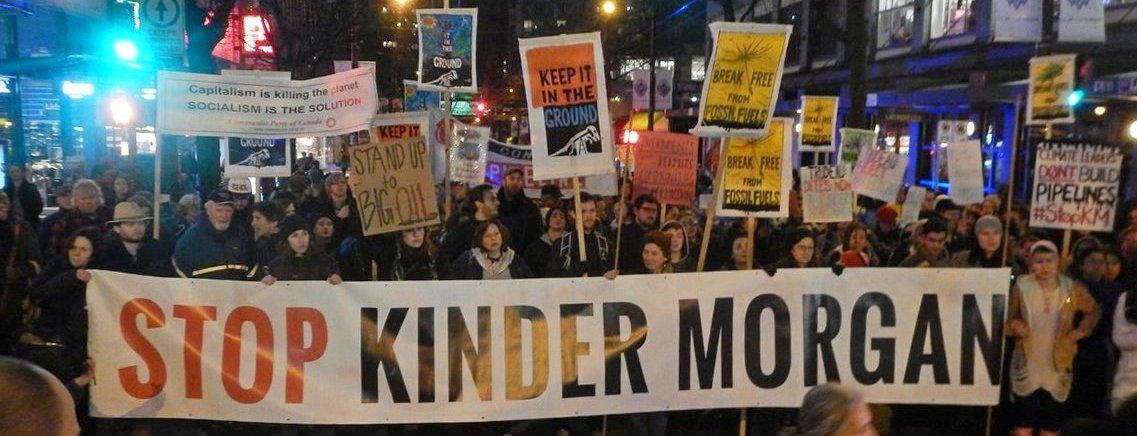
Demonstration against Kinder Morgan pipeline, Vancouver, November 29,
2016. (H. Syed)
Trudeau says pipelines "lead to
economic
growth and
good jobs"
The idea that pipelines are necessary to create higher
paying
jobs is hyped by the western provincial and federal governments,
as well as the energy industry. The rights of the Indigenous
nations, environmental concerns and the need to reduce greenhouse
gas emissions are pitted against what is presented as a solution
to unemployment and the serious problems of the economy,
especially the tens of thousands of currently unemployed oil
workers.
The working class is overwhelmed with ever-inflated
numbers
of the jobs that go along with the building of pipelines
providing it with both false hopes and false consciousness.
President Trump repeats the long-discredited number of 28,000
jobs in the U.S. for the Keystone XL pipeline. In Canada, the
U.S.-controlled oligopoly Kinder Morgan initially pegged the
number of spin-off jobs for its Trans Mountain line expansion at
2,000, but now says twinning the existing line will result in
"the equivalent of 37,000 direct, indirect and induced jobs per
year." After completion, only 90 workers will be required to
operate the two lines. What will the other 36,910 workers be
doing in their "equivalent" jobs?
Kinder Morgan says construction will involve up to
4,500
workers at peak over two years. What is not explained is that
pipeline construction typically takes place in the summer, except
in muskeg or swamp areas where work can proceed when the ground
is frozen. Contractors bid on sections of the pipeline, and the
average length of a job to complete one section is usually three
months or less, while an exceptionally long run might be four
months.
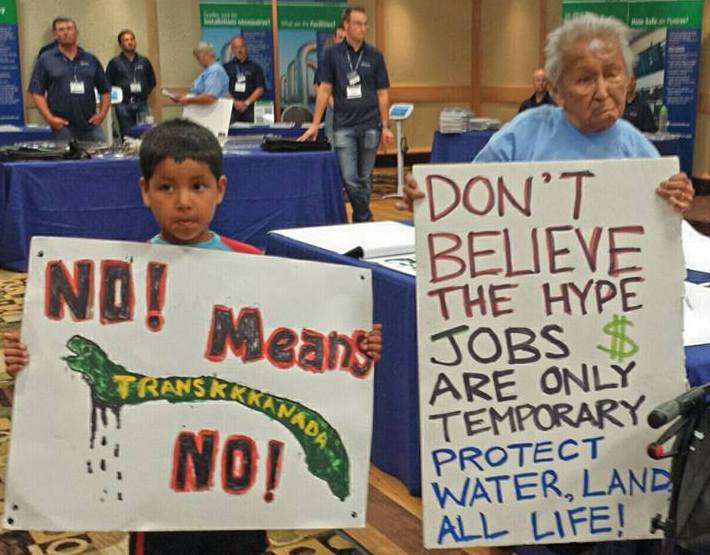 Not only are the employment
numbers inflated, they are
impossible to verify. Even more significant is that the
calculation of "direct, indirect and induced jobs" is based on an
all or nothing scenario. Either accept the decisions made by the
oligopolies as to the direction of the economy including heavy
reliance on investments to extract and ship diluted bitumen, or
nothing. Those who challenge this logic are dismissed as
unreasonable and opposed to economic development. Even existing
alternatives to the export of unprocessed bitumen are not
discussed because the oligarchs and their political
representatives do not allow them to be discussed. Not only are the employment
numbers inflated, they are
impossible to verify. Even more significant is that the
calculation of "direct, indirect and induced jobs" is based on an
all or nothing scenario. Either accept the decisions made by the
oligopolies as to the direction of the economy including heavy
reliance on investments to extract and ship diluted bitumen, or
nothing. Those who challenge this logic are dismissed as
unreasonable and opposed to economic development. Even existing
alternatives to the export of unprocessed bitumen are not
discussed because the oligarchs and their political
representatives do not allow them to be discussed.
For reference, a comparison with the construction and
future
operation of the Sturgeon refinery now under construction in
Redwater, close to Edmonton, is revealing. The estimated price of
production to build the refinery is $8.5 billion, while the Trans
Mountain pipeline is estimated at $6.8 billion. A comparison
shows that investments in pipelines actually rate quite poorly
when compared to an investment in refining capacity to serve the
Canadian market.
Phase One of the Sturgeon refinery is now nearing
completion,
the first new refinery built in Canada in more than 30 years. It
will produce 80,000 barrels a day of ultra-low sulphur diesel
fuel, as well as diluent and low-sulphur vacuum oil and other
products that can be used in the petrochemical industry.
Canada imports all of these products now, and all
production
from this phase at Redwater will serve the Canadian market. A
gasification unit will take the heaviest, lowest-value portion of
the feedstock bitumen and convert it into hydrogen and pure C02,
which will be used in a carbon capture system to be injected into
existing oil wells in central Alberta to "enhance oil recovery
from mature fields."
The Sturgeon refinery project will have taken four
years when
completed later this year. In June 2016, 5,200 workers were on
the construction site, with another 3,000 workers in modular
yards around Edmonton. This brings the total peak of construction
workers to 8,200, while the non-peak workforce has been about
5,000 workers including engineers and NW Refining staff. Around
500 workers are required for Phase One production. Two additional
phases were included in the initial design, but their future is
uncertain.
The Sturgeon refinery will process 78,000 barrels of
bitumen
a day. The province will provide 75 per cent of the project's
feedstock through its bitumen royalty-in-kind program (BRIK),
while the remaining 25 per cent will come from Canadian Natural
Resources. Canadian Natural Resources owns the project in a 50/50
joint venture with NW Refining. BRIK was designed under the
government of Ed Stelmach to encourage in-province upgrading,
refining and petrochemical development. Since the financial
crisis of 2008 and crash in oil prices in 2014, the oil
monopolies have lost interest in building refining and upgrading
capacity in Alberta, and the Sturgeon refinery has only proceeded
with arrangements where the risk is borne by the people of
Alberta.
The government pays the refinery a processing fee or
toll and
retains ownership of the bitumen. The provincial government also
has a 25 per cent stake in the project through the Alberta
Petroleum Marketing Commission, but only so long as the
"subordinated debt" is outstanding.
Ian McGregor, CEO of NW Refining, claims significant
environmental benefits from the project, saying the diesel
produced has the lowest sulphur content of any diesel fuel
produced in North America. Needed pipeline capacity is reduced by
one-third as bitumen flow can be maintained without adding
diluent. The refinery has a carbon capture system, which will
ship about 4,000 tonnes a day of C02 by pipe from the refinery to
central Alberta and a nearby Agrium fertilizer plant for
injection into mature oilfields for enhanced oil recovery.
(To put this carbon capture in perspective, the 4,000
tonnes
a day of C02 amount to about 1.5 megatonnes annually. Total CO2
production from the oilsands is now about 70 megatonnes/year and
has been capped at 100 megatonnes/year).
"I have a basic belief in Alberta that we are really
good at
making logs but we had better quit doing that and start making
furniture or there's not going to be a very good future," NW
Refining CEO McGregor stated recently.
McGregor challenges the need for new pipelines,
pointing out
that shipping bitumen requires about one-third of the pipeline
capacity for added diluent to make the bitumen flow. He also
points out that adding pipelines to export dilbit (bitumen plus
diluent) may well leave Alberta with no oil for refining and the
petrochemical industry given the projected oil production
capacity.
The Sturgeon refinery is being built because of direct
government involvement where the state assumes the risk, while
ownership and control remains in private hands. An alternative
would be to use state investments to establish refining and
manufacturing capacity under public service control and state
ownership, with companies like NW Refining acting as hired
contractors.
The workers themselves, especially the energy and
building
trades workers whose lives are made so precarious by the present
rip and ship direction must themselves find a way forward through
their own initiative. Those elements entrenched in class
privilege and control of the economy and their political
representatives have no interest in change unless it consolidates
their privilege and control. A new direction for the economy to
serve the people and build vibrant thriving communities can only
come from the initiative of the workers, their allies and
political representatives themselves forming a powerful movement
along with the institutions they require to bring in the new.

Alberta's Petrochemical Diversification Program
- K.C. Adams -
No to pay-the-rich schemes -- time
for a
twenty-first century
nation-building project
Many in Alberta pay lip service to the need for
diversification of the economy, at least during the bust part of
the boom and bust cycle. Especially starting with the crash in
oil prices in the 1980s, when governments speak of
diversification they mean pay-the-rich schemes. Private monopoly
interests are given grants or interest-free loans to "incent"
them to make investments. The Alberta government's Petrochemicals
Diversification Program does not stray from this model.
 The government invited the
energy oligopolies to submit
proposals and then chose two for its Petrochemicals
Diversification Program. Together, they will receive $500 million
in grants from the state treasury on completion of the two
facilities, which will process propane extracted from natural gas
making plastics products propylene and polypropylene. The government invited the
energy oligopolies to submit
proposals and then chose two for its Petrochemicals
Diversification Program. Together, they will receive $500 million
in grants from the state treasury on completion of the two
facilities, which will process propane extracted from natural gas
making plastics products propylene and polypropylene.
The amount awarded the two global oligopolies is
greater than
the total $493 million in royalties the Alberta government
claimed from natural gas producers in 2016. Working people should
think deeply about this backward use of state funds,
which are in effect a portion of the social wealth Alberta
workers produce and should belong to them by right.
A joint venture between Pembina Pipeline Corporation
and
Petrochemical Industries Company (PIC), will receive up to $300
million in provincial royalty credits to build an integrated
propylene and polypropylene plant in Sturgeon County at an
estimated price of production of $4 billion. PIC is a subsidiary
of the Kuwait Petroleum Corporation, Kuwait's national oil
company.[1]
Inter Pipelines will receive up to $200 million in
royalty
credits to build a $1.85 billion facility in Alberta's Strathcona
County. The plant will also produce propylene and polypropylene.
Inter Pipelines is a subsidiary of Koch Enterprises, owned by the
notorious Koch Brothers, one of the richest families in the
world.[2]
The pay-the-rich schemes amount to the following: some
of the
richest people on the planet, who have amassed incalculable
social wealth from the control of natural resources and the work
of hundreds of thousands of workers, are invited to Alberta to
plunder Mother Earth's natural bounty using the hard work and
expertise of Alberta's working class and the existing
infrastructure. But that is not enough for the oligarchs. They
are "incentivized" to pillage the province's land and labour with
a promised gift of half a billion dollars from the state
treasury.
Once in production, the oligarchs are free to do as
they
please with most of the new value workers produce, which is
declared their private property. Generally, the new value workers
produce is not invested back into the local economy but spirited
off by those in control to where another government is offering
"incentives" or a big score is anticipated. This is not the way
to diversify the economy regardless of the grandiose title given
to the program.
These energy oligopolies from the U.S. and elsewhere
cannot
operate in Alberta without skilled workers educated for the most
part in Canada's public schools and cared for when sick or
injured in Canada's health care system. These plants also require
Alberta's natural gas and the extensive infrastructure needed to
extract it from the land and transport it to the plants.
Think about it for a moment. The investments and value
produced in all the public services, social programs and
infrastructure these plants require to operate have to be
realized in exchange for the value the workers in the new plants
produce. Instead, the state is giving those in control of the new
plants social wealth from state coffers and, as well, most of the
added-value workers in those plants produce can be spirited away
by the oligarchs to who knows where. How is this sustainable? How
does this grow the economy or diversify it? This is not
nation-building in the twenty-first century. For Alberta and
Canada's economy to grow and diversify and become stable and
secure, it needs the internally produced added-value to be poured
back into the economy for extended reproduction of different
sectors, both means of production and articles of
consumption.
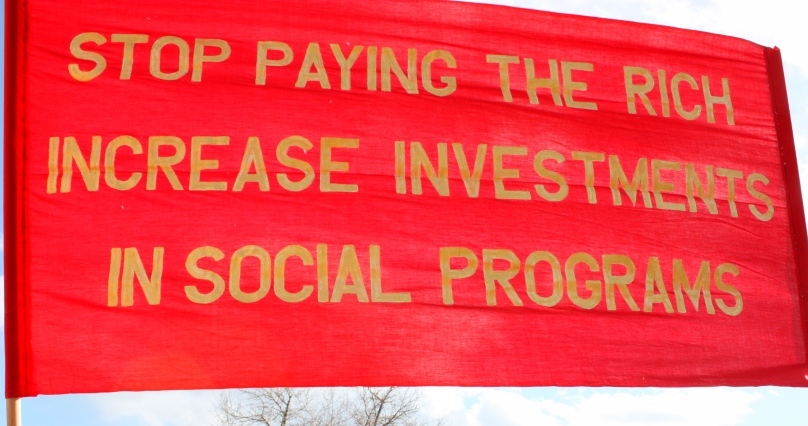 How can health care,
education, seniors' care, care for the
most vulnerable, transportation and other infrastructure and a
host of necessary social programs, public services and
manufacturing of a modern society be financed when those
companies consuming the social wealth those sectors produce
refuse to pay for it but instead demand to be paid for the right
to use them and to take added-value out of the economy for use
elsewhere? These pay-the-rich schemes such as the high-sounding
Petrochemicals Diversification Program are profoundly irrational
and backward, and exacerbate the contradictions, tensions and
social conflicts within the economy and society dragging them
down into insecurity and recurring crises. How can health care,
education, seniors' care, care for the
most vulnerable, transportation and other infrastructure and a
host of necessary social programs, public services and
manufacturing of a modern society be financed when those
companies consuming the social wealth those sectors produce
refuse to pay for it but instead demand to be paid for the right
to use them and to take added-value out of the economy for use
elsewhere? These pay-the-rich schemes such as the high-sounding
Petrochemicals Diversification Program are profoundly irrational
and backward, and exacerbate the contradictions, tensions and
social conflicts within the economy and society dragging them
down into insecurity and recurring crises.
Provincial Minister of Economic Development and Trade
Deron
Bilous said the scheme was necessary to "lure" the investment to
Alberta rather than Texas or Louisiana and would "level the
playing field." In other words these oligopolies hold governments
hostage, demanding various pay-the-rich schemes or they will go
elsewhere. This is not a game governments in Canada should be
playing. Robbing the state treasury to benefit the Emirate of
Kuwait and the U.S. Koch Brothers is exactly the kind of deals
that should be prohibited by law as criminal corruption.
Even the claim that the plants would not otherwise be
built
is spurious. Canada has lost its U.S. market for natural gas due
to the U.S. fracking spree resulting in a glut of propane. What
to do with the propane forms a big part of the motivation for
building the plants. If they can be paid to do so, so much the
better from the point of view of the rich.
The dangers posed with these schemes cannot be ignored.
The
Don Getty Alberta government did the same when oil prices tanked
in the 1980s. The state deficit from paying the rich was then
used by Premier Ralph Klein as a pretext to launch the most
vicious anti-social offensive in the history of Canada.
Everything was on the chopping block when it came to the social
programs and public services the people need and a modern society
requires for its existence. Today, the state deficits from these
new pay-the-rich schemes and the refusal to open a new direction
for the economy will be used down the road by the Jason Kenneys
and others of his ilk to attack the people and society with a
vengeance.
The conception that the Koch Brothers and Kuwaiti
emirates
are going to secure Alberta's future boggles the mind. Such
ridiculous deals tighten the stranglehold of the very rich over
the wealth the working class produces and its potential. Far from
strengthening the economy, it weakens it with increased class
privilege and control, with the rich taking wealth out of the
economy, local communities and province in ever greater amounts
and abandoning the province altogether when the inevitable crisis
erupts.
An obvious question is staring the working people in
the
face: if these manufacturing plants make sense, why would Alberta
not fund its own state-organized enterprise to build and operate
the facility instead of paying Kuwait's national oil company and
the Koch Brothers for the privilege. The new social wealth
workers produce at the plastics plants would then be available to
be poured back into the economy in increased investments in
social programs, public services, infrastructure and other state
enterprises not to speak of properly realizing the social wealth
the plants consume. That is called nation-building in the
twenty-first century.
Notes
1. The Pembina Pipeline/PIC
Joint Venture will involve from
2,000 to 2,500 construction jobs at peak and take about two years
to complete. The plant in operation will employ about 150 people
processing 22,000 barrels per day of propane into
polypropylene.
2. The Inter Pipelines plant,
it is said, will take about
three years to build with a similar number of workers involved in
construction as the Pembina Pipeline/PIC Joint Venture and about
95 workers upon completion processing propane into
polypropylene.

Quebec People's Legitimate Concern over Fracking
- Fernand Deschamps -
 
The Liberal government of Philippe Couillard last
December
9 passed Bill 106 An Act to implement the 2030 Energy Policy
and to amend various legislative provisions. Subsequently,
the government is attempting to allay the fears and major
concerns of municipalities, farmers and local populations living
close to hydrocarbon exploration and operations of the petroleum
industry.
Quebec contains non-negligible quantities of natural
gas
trapped in a geological formation called the Utica Shale. This
geological formation is present in the St. Lawrence Lowlands
between Montreal and Quebec City. The area between Portneuf and
Beaupré near Quebec City is also potentially rich in oil in the
same rock formation. The Utica Shale is composed primarily of low
permeability shales that contain non-negligible quantities of
natural gas (mainly methane) that is already extracted in
Pennsylvania by the method called hydraulic fracturing (or
fracking).
Because the Utica Shale formation is not very
permeable, the
only way to release the gas (or oil) trapped in the shale is to
drill a vertical well, which is then deflected horizontally for a
distance of 1 to 2 km. Once the well is drilled, huge quantities
of water totalling millions of litres or the equivalent of
several thousand loads of water-filled tanker trucks are pumped
under high pressure into the well. This fluid is enriched with a
retaining agent or proppant (sand or ceramic microbeads) that
forms 10 per cent of the liquid solution. This retaining agent
fills the fractures caused in the rock by pressurized water and
eventually allows the gas trapped in the shale to escape.

Click to enlarge
The injected fluid also contains about 0.5 per cent of
chemical additives. The additives are predominantly toxic
biocides intended to prevent the development of possible
bacteria, which would complicate the extraction process. Section
80 of Bill 106 describes this entire process of hydraulic
fracturing as "a well by physical, chemical or other
stimulation."
The mixture of liquid once injected under pressure is
then
mostly recovered a few hours or days later and deposited as brine
in surface recovery tanks to be used again or moved to permanent
storage. Generally, neighbouring municipalities close to fracking
operations have refused to treat this wastewater (referred to as
"brine" in Bill 106) because municipal wastewater filtration
systems are not suitable for filtering complex wastewater from
fracking wells. For this reason, the operators of fracking wells
resort eventually to storage of their brine in either natural
underground reservoirs or those created during fracking.
Who is Responsible for Environmental Damage?
Chapter IV of Bill 106 "Permanent Well Closure and Site
Restoration Plan" states that any company engaged in fracking and
doing the drilling and operating the well(s) is pledged to create
a situation whereby, "in the Minister's opinion, the condition of
the territory affected by the work or activities no longer poses
a risk for the environment or for human health and safety"
(section 106, paragraph 2).

The question arises whether or not "the Minister's
opinion"
is based on the best scientific and environmental practices for
the remediation and rehabilitation of hydraulic fracturing sites.
Those best practices include dealing with contaminated or
polluted sites and returning damaged or degraded land to
beneficial use. Section 123, Chapter VII in Bill 106 "Optimum
Petroleum Recovery and Brine" states, "An exploration, production
or storage licence holder must recover petroleum and brine
optimally using generally recognized best practices for ensuring
the safety of persons and property, environmental protection and
optimal recovery of the resource."
According to the restricted definition of best
practices in
Bill 106, the company responsible for fracking and the resulting
brine is not required to return the contaminated site to its
original state for beneficial use. It has become well-known that
most fracking operations do not fully recover their wastewater,
as brine leaks into existing or reactivated fractures. This
experience makes problematic even the restricted definition of
best practices in Bill 106 regarding the storage of brine to
ensure "the safety of persons and property, environmental
protection and optimal recovery of the resource."
It Is the People Who are Made to Pay the Price for
Fracking
Section 119, Chapter VI in Bill 106, "Liability and
Protective Measures" states:
"An exploration, production or storage licence holder
or a
junction pipeline authorization holder is required... to make
reparation for any injury caused through or in the course of
their work or activities, including a loss of non-use value
relating to a public resource, in particular due to emanations or
migrations of gas or spills of oil or other liquids.
"[Also] The holder must provide proof, in the form and
manner
the Government determines by regulation, that they are solvent to
an amount determined by the Government."
 The experience of workers
in Quebec and the rest of Canada is
that when a company is obliged to pay for damages caused to the
environment, it always tries to pay the least it can, not to
return damaged, contaminated, degraded or polluted sites to
beneficial use and compensate all who have been affected. When
all judicial recourses have been exhausted, the company will
declare bankruptcy under commercial law so as not to be forced to
pay for the full damage it caused. The experience of workers
in Quebec and the rest of Canada is
that when a company is obliged to pay for damages caused to the
environment, it always tries to pay the least it can, not to
return damaged, contaminated, degraded or polluted sites to
beneficial use and compensate all who have been affected. When
all judicial recourses have been exhausted, the company will
declare bankruptcy under commercial law so as not to be forced to
pay for the full damage it caused.
To all this is added the dangers caused by the
activation of
fractures and dormant faults near zones where hydraulic
fracturing occurs. A study in Alberta and British Columbia, and
another in the United States by the U.S. Geological Survey found
a link between an increase in seismic activity in several states
and the injection of wastewater into wells used for brine storage
resulting from fracking operations. Earthquakes have increased in
Oklahoma since fracking began including one of magnitude 5.7 in
2011, which destroyed 14 houses and injured 2 people.[1] This is occurring in an area that
was not previously recognized as an active seismic zone. The
geological phenomenon represents the movement of fractures and
dormant faults that have been activated by the introduction of
fluids (in this case wastewater from fracking operations) into
underground reservoirs.
Underground reservoirs for storing brines, a by-product
of
fracking, are often located in porous rock formations that are
generally located close to the surface but deeper than
groundwater to avoid contamination. However, some scientists have
raised the issue that because no studies exist to monitor the
movement of brines along these fractures where earthquakes have
been observed, as in the case in Oklahoma and also in Alberta and
BC, no assurance can be offered that these brines will not travel
up rock formations to contaminate groundwater. Such a situation
would be a disaster in the making for all municipalities and
farms close to fracking operations, which depend on groundwater
to supply the local human and animal population with safe drinking
water.

Demonstration against Bill 106, Quebec City, August 16, 2016.
The St. Lawrence River flows through the broad St.
Lawrence
Valley, which is geologically recognized as an old tectonic rift.
Known (and unknown) secondary faults exist on both sides of the
North and South shores of the river. Fracking and/or brine
storage operations near those faults could activate them. One needs to
ask the Premier of Quebec, and the government is obligated to disclose,
the science behind Bill 106 authorizing oil and gas companies to engage
in large-scale fracking and underground brine wastewater storage
operations in the St. Lawrence Lowlands. The government is obligated to
disclose fully the science behind Bill 106. A chance must be
given to all concerned to challenge the findings, which is how
science should be practiced, examining every possibility of
danger to life and the social and natural environment, including
the water. Without doing so, Bill 106 remains an irresponsible
act jeopardizing the life and safety of tens of thousands of
people and the general well-being of the social and natural
environment.
Note
1. Becklumb, Penny et al, Shale
Gas
in
Canada,
Environmental
Risks
and
Regulation, Library of
Parliament, Publication 2015-18e, 2015, Ottawa, p.16.

Neo-Liberal Reforms to Canada
Transportation
Act
Workers Demonstrate Against
Deregulation and Privatization

Vancouver, February 23, 2017
On February 23, transportation workers in Vancouver,
Prince Rupert and elsewhere rallied to oppose the federal
government's plans to privatize sea and airports and dismantle
cabotage. Workers denounced the federal government's endorsement
of the review of the Canada
Transportation Act known as the
Emerson Report, first commissioned by the Harper government in
2014. The report advocates deregulation and privatization to hand
over control of maritime, air, rail and truck transport systems
to the global oligopolies in the name of making Canada
competitive on global markets.
In Vancouver, workers marched through the downtown area
led by members of the International Longshore and Warehouse Union
(ILWU) Canada, Seafarers' International Union (SIU) of Canada, UNIFOR,
the BC Ferry and Marine Workers' Union, the International Union of
Operating Engineers. Representatives of the Maritime Union of
Australia, the International Transport Workers' Federation (ITF) and
the BC Federation of Labour were also present. The slogan emblazoned on
the shirts of many present was, "Our Coasts, Our Jobs, Our Future."
A main concern highlighted by the maritime workers was
to
defend cabotage, the system that ensures that commercial maritime
work in Canadian waterways is done by Canadian workers,
trained for the work, on Canadian-registered ships. The Emerson
Report recommends the deregulation of cabotage by opening it up to
foreign vessels, many flying flags of convenience or employing
temporary foreign workers in brutal conditions. Workers also raised
opposition to the recently-adopted Comprehensive Economic and Trade
Agreement (CETA) between Canada and the European Union which threatens
to eliminate cabotage. Speakers noted that in this context, cabotage
helps to defend the living and working conditions of Canadian maritime
workers, protects the most vulnerable foreign workers, and contributes
to the safety of Canadian waters and the environment.
|

ILWU Canada President Rob Ashton
addresses rally.
|
Rob Ashton, President of ILWU Canada said, "This is to
protect families of our nation. [...] If [corporations and the
government] have an ability to break us and to tear us down, who is
going to protect those seafarers that are coming to our shores, who is
going to protect them when they need to be protected? Who is going to
protect the marginalized workers who are brought into this country as
slave labour because they are not paid properly, they are not allowed
to become Canadian citizens? It is us as Canadians who have to rise and
stand up against those who want to do harm to our people and to those
they are bringing to our country and they treat like slaves. And how do
we do that? We stand up and fight back."
Terry Engler, president of ILWU Local 400 pointed out,
"Workers fought to bring in regulations to cover those workers,
to bring regulations on safety, on crew sizes, to protect our
security. This protects our environment because we are able to
say 'you cannot do that here.' We have seen what happens around
the world when corporations are allowed free rein. If we lose
cabotage, if we don't have regulations and inspectors, which they
need more of, our world will be destroyed far worse than it is
now."
Workers pointed out that a main goal of deregulation
and
privatization is to smash the resistance of unionized workers and
smashing unions as a line of defence of the working and living
conditions of Canadians. The militant stand of workers made it
clear that ports, airports, waterways and everything else
required for the modern economy on which Canadians depend belong
to the people and the society, not private interests.
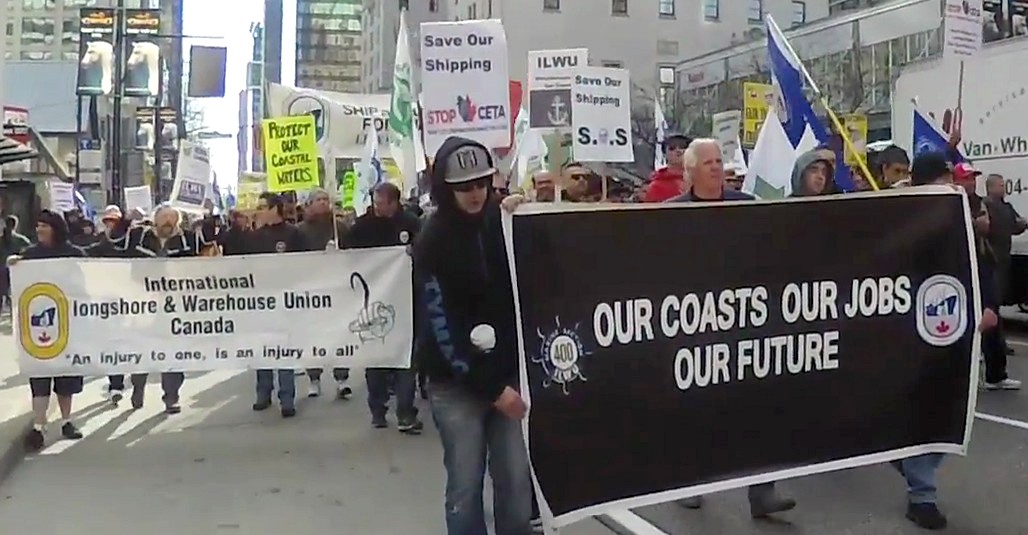
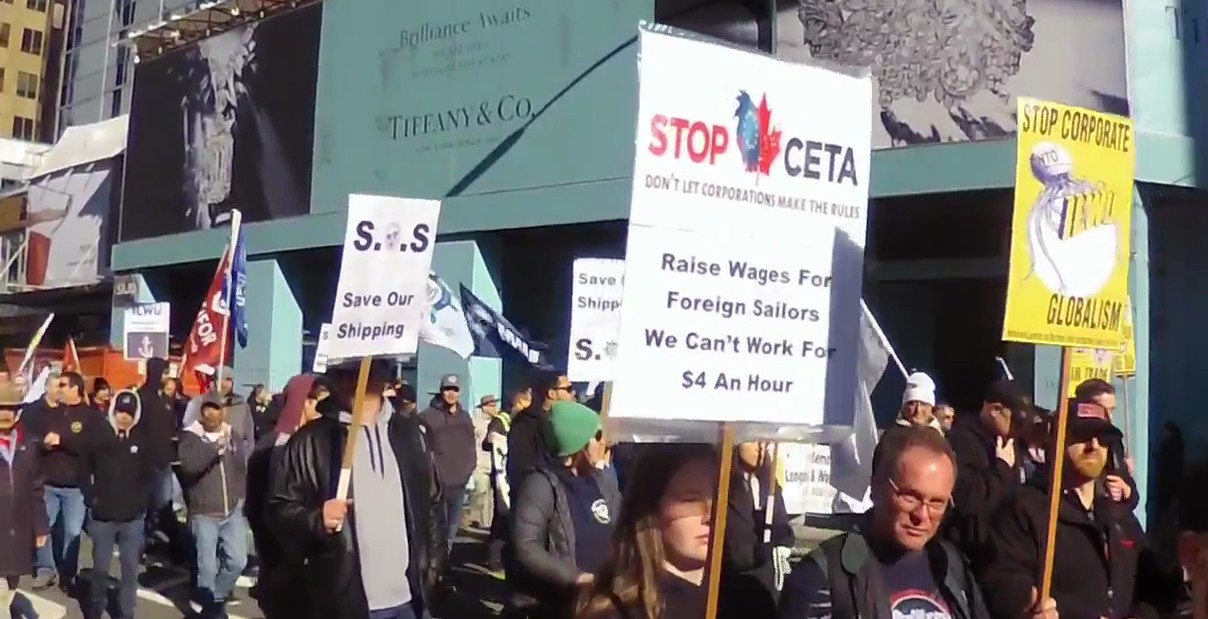 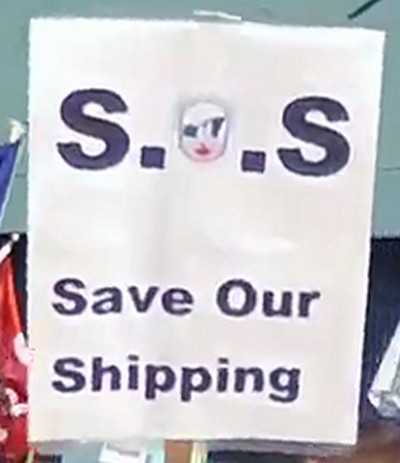

 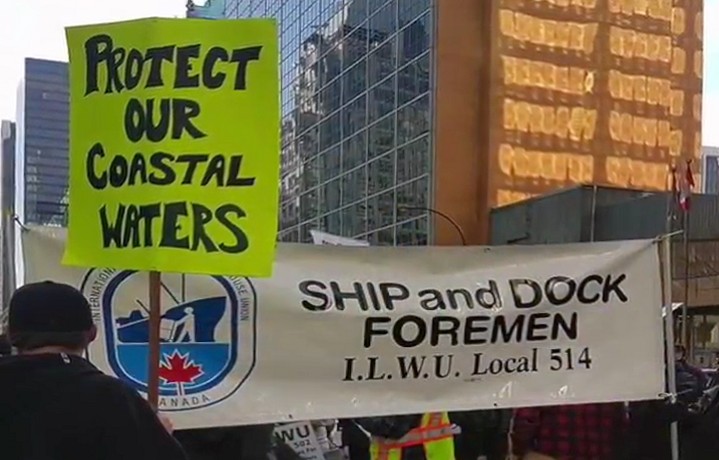
 

Nation-Wrecking Reform of Canada's
Transportation System
- Workers' Centre of CPC(M-L) -
Federal Minister of Transport Marc Garneau is
spearheading
a reform of the Canada Transportation Act (CTA) and
Canada's transportation system. The stated aim is to make his
strategic plan Transportation
2030 part of the Trudeau Liberal
government's goal of "making Canada competitive on global
markets."
From April to September, 2016 the Minister of Transport
held
consultations on five themes: Safer transportation; Trade
corridors to global markets; Green and innovative transportation;
The traveller and waterways; Coasts and the north.
 Changes to the CTA are
expected to be implemented in the
coming months and years. For this, the Minister of Transport is
using as a guide what is commonly called the Emerson Report. The
Harper government commissioned a review of the CTA in June 2014.
David Emerson, a former member of the Harper government cabinet
chaired the committee mandated to do the review. Liberal Minister
Garneau tabled the Emerson Report in Parliament on February 25,
2016. In a number of speeches, he said that the report was
"excellent" and would serve as a guide to the reform of the
CTA. Changes to the CTA are
expected to be implemented in the
coming months and years. For this, the Minister of Transport is
using as a guide what is commonly called the Emerson Report. The
Harper government commissioned a review of the CTA in June 2014.
David Emerson, a former member of the Harper government cabinet
chaired the committee mandated to do the review. Liberal Minister
Garneau tabled the Emerson Report in Parliament on February 25,
2016. In a number of speeches, he said that the report was
"excellent" and would serve as a guide to the reform of the
CTA.
Workers in the transportation sector have been raising
the
alarm, warning Canadians that the Trudeau government is about to
adopt nation-wrecking recommendations from the Emerson Report.
They point out the report's disturbing demands for deregulation
and privatization of transport services and infrastructure, and
the increased imposition of user fees. The report recommends the
privatization of airports and ports, and the opening up of
cabotage rights for internal waterways to European vessels, many
of which fly European "flags of convenience" and have wages and
working conditions far below accepted standards. The report also
recommends legislative changes to increase foreign ownership
limits to at least 49 per cent for air carriers operating
commercial passenger services and to 100 per cent for airlines
operating all-freight and specialty air services. In a recent
speech, the Minister of Transport said as a first step he is
planning to implement this year the Emerson recommendation to
allow an increase of foreign ownership of air carriers to 49 per
cent.
Thesis of the Emerson Report
The Emerson Report is entitled "Pathways: Connecting
Canada's
Transportation System to the World." The report is 286 pages with
230 additional pages of appendices. It begins with a letter to
former Conservative Minister of Transport Lisa Raitt, followed by
thirteen chapters: Points of Departure; Governance; Linking Trade
and Transportation; The North; Innovation; Climate Change; Access
and Accessibility; Rail Transport; Air Transport; Marine
Transport; Canadian Transportation Agency; Summary;
Recommendations.
The report defines Canada as a trading nation,
depending on
international trade for its prosperity. It says: "What has not
changed over many decades, and will probably never change, is the
fundamental reality of Canada as a large northern land mass with
a comparatively small population. We are a nation dependent on
international trade to support a uniquely attractive quality of
life and standard of living. We share the North American
continent with the world's most dynamic economy, the United
States, and with one of the more dynamic developing economies,
Mexico. North American integration and collaboration is both a
reality and a necessity, whether for economic, security, or
environmental purposes."
This Canadian nation, states the report, is now facing
a
world in turmoil, and its fate is linked with its ability to
annex itself to this world in crisis and to compete within it. A
basic tenet of the report is that Canada cannot be master of its
own destiny on the basis of a pro-social sovereign and diverse
economy under the control of its people, where international
trade acts as an additional support to the independent internal
economy.
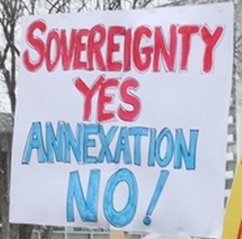 Instead, as a dominated
trading nation, which does not even
own or control its basic sectors, it cannot control the demand or
prices for its resources; it has no say over economic development
and must leave such decisions to unknown "investors" who must be
enticed to invest with guaranteed promises of big scores. This
trading nation, at the mercy of the global market, cannot protect
itself from the inevitable cyclical crises within the imperialist
system of states dominated by the U.S. Empire, both from the
generalized economic crises such as erupted in 2008 and from
sectoral crises such as the current one of market prices for
energy resource commodities and others below their prices of
production. Instead, as a dominated
trading nation, which does not even
own or control its basic sectors, it cannot control the demand or
prices for its resources; it has no say over economic development
and must leave such decisions to unknown "investors" who must be
enticed to invest with guaranteed promises of big scores. This
trading nation, at the mercy of the global market, cannot protect
itself from the inevitable cyclical crises within the imperialist
system of states dominated by the U.S. Empire, both from the
generalized economic crises such as erupted in 2008 and from
sectoral crises such as the current one of market prices for
energy resource commodities and others below their prices of
production.
The report says, "Since the last Review, changes in
global
markets, technology, security threats, environmental
vulnerabilities, and the patterns of economic growth and
development within Canada have reinforced a reality of the
twenty-first century: we live in an intensely interconnected
world that is constantly rocked by change, much of it
unanticipated....
"While Canada's 36 million people thrive from our
interaction
with the 7.3 billion people in the world, we are a modest global
force, responding to, but largely unable to control global
events. The fact that connectedness to the world economy provides
life-giving oxygen to the Canadian economy has two critical
implications. First, the role of transportation and logistics --
the efficient movement of people and goods -- has become
increasingly critical to international competitiveness. In fact,
transportation logistics and supply chain efficiency is now seen
by various research organizations as more important to global
competitiveness than duties and tariff rates. Second, turbulence
and change beyond our borders permeate quickly and deeply into
the economic life of Canadians. A major challenge, therefore, is
to develop our capacity for rapid adaptation to natural disasters
and other predictable disruptions, as well as to emerging trends
and changes that are hard to foresee and largely beyond our
control.
"Global security issues will also continue to play a
role in
shaping transportation and trade linkages. Creeping military and
nuclear capability, coupled with religious, ethnic, and
territorial tensions, will limit flows with some countries and
expand them with others. Adaptive transportation systems will
require increasingly sophisticated security arrangements
integrated into the chain of movements."
Once all this is accepted as a truism, the only
prospect for
Canada is to become a global hub for global trade amongst the
world oligopolies. What Canada mainly brings to the table is its
abundance in natural resources, which it exports to the global
markets.
"The extent to which slowing economic growth, volatile
markets in Asia, and slumping commodities prices have buffeted
Canada's economy and public finances over the past year is a
strong reminder that ours is a small, open economy, more likely
to be influenced by global events than to shape them. And though
the value of our dollar has declined recently and interest rates
are low -- which helps to improve Canada's cost competitiveness
in international trade and encourages new investment -- Canada
should not base its economic growth forecasts on this situation
remaining static. Over time, global development will continue to
drive demand and competition for agricultural products, as well
as energy and other natural resources. Subject to our ability to
capitalize on new markets, these commodities represent huge
export opportunities, and all are intense users of
transportation."
It flows from this that Canada participates in this
venture
by making sure that its transportation system is driven by what
the report calls "competition," "market forces" and
"commercialization," and by privatization of national assets,
deregulation of policies and increasing use of user fees. The
entire country is to be transformed into a giant supply chain for
the transportation of mostly raw and semi-processed goods to the
global markets while annexed within fortress North America
dominated by a U.S. imperialist government of police power both
internally and internationally.
This agenda proceeded from the Harper government's
enthusiastic
support of full North American integration demanded by the U.S.
political and business elites.
In October 2014 a task force report issued by the
Council on
Foreign Relations outlined the agenda for such a plan. The Task
Force was co-chaired by David H. Petraeus -- retired U.S. Army
general, ex-Director of the CIA and now chairman of the KKR
Global Institute, and Robert B. Zoellick -- former president of
the World Bank Group and chairman of Goldman Sachs' international
advisors.
The report points out that the Security and Prosperity
Partnership initiative -- a series of meetings of the U.S.,
Canadian and Mexican governments to promote measures to bring the
economies and security arrangements of North America under U.S.
imperialist control -- "fell far short of what is urgently needed
-- a true North American transformation." The transformation
required is described in great detail: "The task force believes
that today's challenge is to envisage a North American vision,
frame a concept of North American policy aims and cooperation,
and make this policy agenda a priority.
At that time the Harper government immediately budgeted
over
$70 billion in public funds for what was called the National Policy
Framework for Strategic Gateways and Trade Corridors, including the New
Building
Canada Plan, to build on the infrastructure needed to create a
fully integrated North American economy in the service of
oligopoly interests.
Instead of being centres of economic development where
people
can make a living by building a diverse, balanced and pro-social
economy under their control and the majority of value workers
produce remains in the community and becomes available for
sustained and diverse economic development, the regions become
gateways and corridors for the benefit and adventures of the
global oligopolies over which people have no control.
As it stands, the oligopolies are owned and controlled
in the
centres of the financial oligarchy and other than the value
workers reproduce for their own wages and benefits, the majority
of added-value workers produce flows out those gateways and
corridors to the private coffers of the oligarchs, to the centres
of the financial oligarchy in New York, London and Frankfurt.
This leaves Canada's economy extremely vulnerable to global
economic crises, to price changes of major commodities, such as
the turmoil caused with lower oil and potash market prices, to a
fall in global demand for uranium, copper, coal and other
resources, and to specific sectoral attacks such as the current
unfolding U.S. state-organized attack on Canadian softwood lumber
production.
On Governance
The Emerson Report advocates all-out deregulation and
privatization of the transportation industries so that nothing
comes in the way of private corporations manipulating the economy
for their narrow self-serving interests. To ensure this
domination by the oligopolies without restrictions, the report
demands the Canadian state play a greater role in what it calls
building the supply chains into a national chain, making sure
that all assets are put at the disposal of empire-building.
The report states, "Unlike jurisdictions such as
Australia,
the United Kingdom, and the European Union Canada does not have
an ongoing private-public sector framework that considers the
entire national system and is geared to strengthening its
contribution to economic prosperity. Divergent but critical
interests such as infrastructure investment, research,
innovation, and the environment need to come together with a
transportation focus. While Transport Canada is the main entity
responsible for the sector, there is no mechanism to integrate
the breadth of interest in transportation across departments,
sectors, or in terms of federal-provincial dialogue.
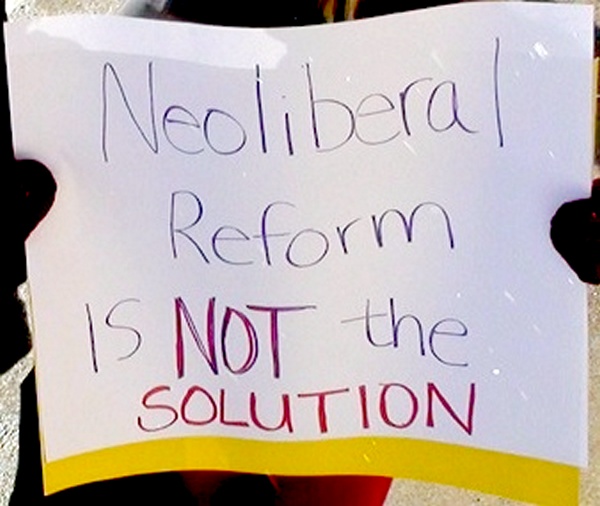 "The goal should be to
embed these policies in a national
framework that builds and optimizes the transportation system
over the next 20 to 30 years. The strategy would identify
investment needs in trade-enabling infrastructure, describe the
proper regulatory and policy environment, and provide long-term
stability for investments and investors in the system." "The goal should be to
embed these policies in a national
framework that builds and optimizes the transportation system
over the next 20 to 30 years. The strategy would identify
investment needs in trade-enabling infrastructure, describe the
proper regulatory and policy environment, and provide long-term
stability for investments and investors in the system."
The
report
details
a process where global private interests
increasingly assume direct state governance in the sense that they
become the decision-makers of what is to be privatized and deregulated,
how the value workers produce is to be distributed, and all other
issues of importance.
"The
Review
recommends
that
Transport Canada lead the development of a clear
performance and evidence-based National Framework on Transportation and
Logistics in collaboration with the provinces, territories and
industry" and "new governance arrangements based on a public-private
sector collaborative approach." It continues: "Including the private
sector in priority setting as a key source of knowledge and expertise
would also improve outcomes. Important investment decisions would be
evidence-based, transparent and intended to maximize results."
The report makes no secret of the aim it pursues of
handing
all power to the private interests of the oligarchs who own and
control the social wealth available for big investments. This
includes the pooled savings of the working class over which the
financial oligarchy has control.
"The Review recommends that the Government of Canada
act to
attract increased private sector financing for transportation
infrastructure projects by:
"a. using the Transportation Infrastructure Plan and
Projects Pipeline ... to identify national priorities (and assets that
could be considered for privatization) and to highlight those projects
and initiatives that may be of interest to private sector investors;
"b. working with institutional investors and pension
funds to
consider additional tools or mechanisms to attract and leverage
private investment in transportation infrastructure. This will
involve:
"i. ensuring existing financial, policy and regulatory
frameworks do not unnecessarily discourage private sector
investment in Canadian transportation projects;
"ii. legislative amendments to remove any barriers,
such as
the restrictive investment regulations on pension funds;
"iii. encouraging and assisting private financial
institutions to establish managed transportation infrastructure
investment funds in which private investors (small and large)
could reduce risk by pooling funds and investments;
"iv. adopting policies and stable, predictable
regulatory
frameworks that de-risk investor cash flows and inspire greater
confidence among institutional investors in P3 and private
infrastructure projects.
"Finally, it would foster a healthy exchange of ideas
and
expertise: members could participate in bilateral fora, such as
the Canada-United States Regulatory Cooperation Council, which
was created to increase regulatory transparency and coordination
between the two countries."
Gateways and Corridors
The Emerson Report devotes a lot of attention to
gateways and
corridors as key elements of the supply chain. It defines them in
the following way:
"'Gateways' are major convergence points for the
international flow of people and cargo. They are the marine
ports, airports, and Canada-U.S. border crossings (by land,
international bridges, or waters) that serve as points of entry
to and exit from Canada.
 "A 'trade and transport corridor',
according to the World
Bank, is a coordinated bundle of transport and logistics
infrastructure and services that facilitates trade and transport
flows between major centers of economic activity. A trade and
transport corridor may include transfer points, such as
intermodal and distribution centres, where goods are changing
hands or being transferred from one transport mode to
another." "A 'trade and transport corridor',
according to the World
Bank, is a coordinated bundle of transport and logistics
infrastructure and services that facilitates trade and transport
flows between major centers of economic activity. A trade and
transport corridor may include transfer points, such as
intermodal and distribution centres, where goods are changing
hands or being transferred from one transport mode to
another."
The report recommends further activation by the
public-private governance structures of the existing gateways and
corridors: the Asia-Pacific Gateway and Corridor Initiative, the
Atlantic Gateway and Trade Corridor Strategy, and the
Ontario-Quebec Continental Gateway and Trade Corridor.
The report says the conditions of global trade are
fluctuating, markets are volatile and crises occur that more or
less idle these huge infrastructures and yet it sees no other
direction for the economy than to continue in the same way. This
direction means privatizing and expanding the existing gateways
and corridors, building more of them and seizing more land in
advance to prepare for even greater expansion.
The report says: "The Review recommends that the
Government
of Canada establish a National Corridor Protection Program within
the next five years, with Transport Canada, Public Works and
Government Services Canada, and provincial governments as
partners. The purpose of this program would be to:
"a. protect trade and transport corridors. Efforts
should
include, but not be limited to, identification of potential
corridor alignments and rights-of-way requirements, consultation
with stakeholders and the public, and acquisition of required
land along the corridor;
"b. protect critical industrial land parcels for
gateway
facility expansion, with the aim of creating an inventory of, and
preserving, port-related industrial areas that could be used to
accommodate future trade growth."
The Review also recommends close collaboration with the
provinces and territories to:
"c. add to the registered titles on the parcels of land
that
are located in close proximity to an existing or an established
future trade and transport corridor;
"d. partner with municipal governments and the private
sector
to improve sound-barrier and anti-vibration standards in building
bylaws for residential developments in neighbourhoods adjacent to
an existing or future trade and transport corridor."
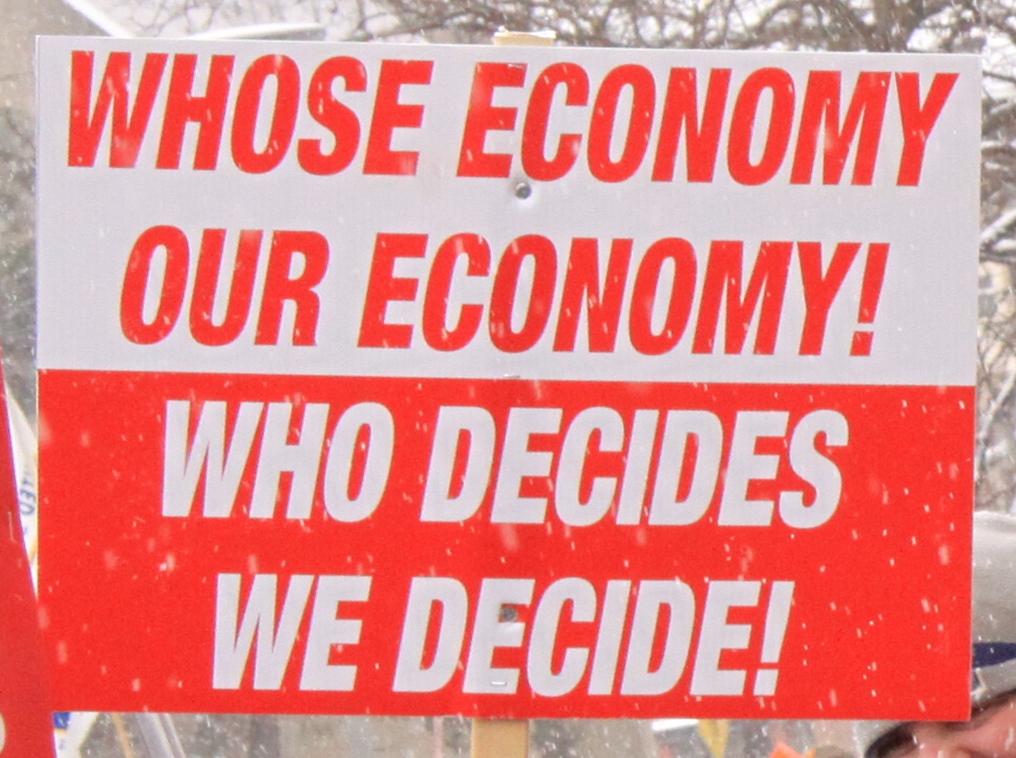 The report calls this
submission to the empire-building
projects of the global oligopolies "nation-building." This
attempts to hide the desperation of selling-out the country to
global investors over which the people have no control. It covers
up the recklessness of committing the nation's assets and the
capacity to work of Canadian workers to the reckless schemes for
big scores of the financial oligarchy and the inevitable economic
crises and commercial wars of a world serving competing narrow
private interests and empire-building. The report calls this
submission to the empire-building
projects of the global oligopolies "nation-building." This
attempts to hide the desperation of selling-out the country to
global investors over which the people have no control. It covers
up the recklessness of committing the nation's assets and the
capacity to work of Canadian workers to the reckless schemes for
big scores of the financial oligarchy and the inevitable economic
crises and commercial wars of a world serving competing narrow
private interests and empire-building.
The Emerson Report is not a basis for reforming and
improving
the Canadian transportation system or any legislation governing
it. The report is a deplorable attempt to put the entire
transportation infrastructure and services, and ultimately the
natural resources of the country and the work-time of workers at
the disposal of the crisis-ridden adventures of global
oligopolies for profit, domination and empire-building. It
deprives Canadians of their right to build a national
transportation system that serves nation-building and a diverse
self-reliant independent economy in a truly modern pro-social way
to guarantee the well-being of the people and humanize the social
and natural environment.

PREVIOUS
ISSUES | HOME
Website: www.cpcml.ca
Email: editor@cpcml.ca
|









 Changes to the CTA are
expected to be implemented in the
coming months and years. For this, the Minister of Transport is
using as a guide what is commonly called the Emerson Report. The
Harper government commissioned a review of the CTA in June 2014.
David Emerson, a former member of the Harper government cabinet
chaired the committee mandated to do the review. Liberal Minister
Garneau tabled the Emerson Report in Parliament on February 25,
2016. In a number of speeches, he said that the report was
"excellent" and would serve as a guide to the reform of the
CTA.
Changes to the CTA are
expected to be implemented in the
coming months and years. For this, the Minister of Transport is
using as a guide what is commonly called the Emerson Report. The
Harper government commissioned a review of the CTA in June 2014.
David Emerson, a former member of the Harper government cabinet
chaired the committee mandated to do the review. Liberal Minister
Garneau tabled the Emerson Report in Parliament on February 25,
2016. In a number of speeches, he said that the report was
"excellent" and would serve as a guide to the reform of the
CTA. Instead, as a dominated
trading nation, which does not even
own or control its basic sectors, it cannot control the demand or
prices for its resources; it has no say over economic development
and must leave such decisions to unknown "investors" who must be
enticed to invest with guaranteed promises of big scores. This
trading nation, at the mercy of the global market, cannot protect
itself from the inevitable cyclical crises within the imperialist
system of states dominated by the U.S. Empire, both from the
generalized economic crises such as erupted in 2008 and from
sectoral crises such as the current one of market prices for
energy resource commodities and others below their prices of
production.
Instead, as a dominated
trading nation, which does not even
own or control its basic sectors, it cannot control the demand or
prices for its resources; it has no say over economic development
and must leave such decisions to unknown "investors" who must be
enticed to invest with guaranteed promises of big scores. This
trading nation, at the mercy of the global market, cannot protect
itself from the inevitable cyclical crises within the imperialist
system of states dominated by the U.S. Empire, both from the
generalized economic crises such as erupted in 2008 and from
sectoral crises such as the current one of market prices for
energy resource commodities and others below their prices of
production."The goal should be to
embed these policies in a national
framework that builds and optimizes the transportation system
over the next 20 to 30 years. The strategy would identify
investment needs in trade-enabling infrastructure, describe the
proper regulatory and policy environment, and provide long-term
stability for investments and investors in the system."
 "A 'trade and transport corridor',
according to the World
Bank, is a coordinated bundle of transport and logistics
infrastructure and services that facilitates trade and transport
flows between major centers of economic activity. A trade and
transport corridor may include transfer points, such as
intermodal and distribution centres, where goods are changing
hands or being transferred from one transport mode to
another."
"A 'trade and transport corridor',
according to the World
Bank, is a coordinated bundle of transport and logistics
infrastructure and services that facilitates trade and transport
flows between major centers of economic activity. A trade and
transport corridor may include transfer points, such as
intermodal and distribution centres, where goods are changing
hands or being transferred from one transport mode to
another."The report calls this
submission to the empire-building
projects of the global oligopolies "nation-building." This
attempts to hide the desperation of selling-out the country to
global investors over which the people have no control. It covers
up the recklessness of committing the nation's assets and the
capacity to work of Canadian workers to the reckless schemes for
big scores of the financial oligarchy and the inevitable economic
crises and commercial wars of a world serving competing narrow
private interests and empire-building.

 In 1987, after being laid
off from his job in Cambridge,
Wendell moved to Hamilton, which became his home. In his new
location he contributed to the work of the non-Party mass press
helping to establish and distribute New Hamilton Weekly.
Besides constant work of the Party, Wendell also became active in
Hamilton Against Poverty (HAP), which he participated in
thereafter. With other HAP members, Wendell organized opposition
to the Harris government's anti-social offensive. He and his
comrades never stopped their resistance, as succeeding
governments at all levels have continued the anti-social
offensive with a vengeance.
In 1987, after being laid
off from his job in Cambridge,
Wendell moved to Hamilton, which became his home. In his new
location he contributed to the work of the non-Party mass press
helping to establish and distribute New Hamilton Weekly.
Besides constant work of the Party, Wendell also became active in
Hamilton Against Poverty (HAP), which he participated in
thereafter. With other HAP members, Wendell organized opposition
to the Harris government's anti-social offensive. He and his
comrades never stopped their resistance, as succeeding
governments at all levels have continued the anti-social
offensive with a vengeance.
 This government represents
a certain type of society which
refuses to recognize that the people of Ontario have the right to
a livelihood, the right to a free, quality education, the right
to 24-hour recreational centres, the right to their own social
consciences. In the 19th century, with the logic of the
criminologists and social workers in Canada, it was promoted that
aggression appears to be an innate human impulse. Poor families
were not guaranteed food, shelter, education or income support,
which led to malnutrition and starvation. Under such conditions,
the youths were forced to steal food and other household
necessities in order to biologically survive and to sustain
themselves and their families.
This government represents
a certain type of society which
refuses to recognize that the people of Ontario have the right to
a livelihood, the right to a free, quality education, the right
to 24-hour recreational centres, the right to their own social
consciences. In the 19th century, with the logic of the
criminologists and social workers in Canada, it was promoted that
aggression appears to be an innate human impulse. Poor families
were not guaranteed food, shelter, education or income support,
which led to malnutrition and starvation. Under such conditions,
the youths were forced to steal food and other household
necessities in order to biologically survive and to sustain
themselves and their families. This legislation seeks to create an
atmosphere where the
youth question nothing, where they don't think for themselves,
where they consider themselves criminals and have no bright
future. It is the spirit of the youth to have their own
conscience, their own thinking, and to be exuberant, rebellious,
to have a spirit of resistance and rebelliousness against the
status quo. This is a factor, this is a symptom of being
youthful, and this cannot be quashed by this legislation.
This legislation seeks to create an
atmosphere where the
youth question nothing, where they don't think for themselves,
where they consider themselves criminals and have no bright
future. It is the spirit of the youth to have their own
conscience, their own thinking, and to be exuberant, rebellious,
to have a spirit of resistance and rebelliousness against the
status quo. This is a factor, this is a symptom of being
youthful, and this cannot be quashed by this legislation.
 One hundred and six years ago, the
first International Women's Day was celebrated to focus on the call for
peace issued by women in Europe prior to World War I. International
Women's Day is in fact from its beginning imbued with the spirit of
proletarian internationalism because it is centred on the striving of
women for their emancipation in the context of the emancipation of the
entire working class and oppressed peoples. Women have always stood in
the forefront of the struggle for rights, peace, and the progress of
society. This shows that the question of women's fight to affirm their
own rights is inseparable from the issue of political power and the
fight of the working people to exercise leadership over the society,
build their own institutions and put an end to exploitation, oppression
and war.
One hundred and six years ago, the
first International Women's Day was celebrated to focus on the call for
peace issued by women in Europe prior to World War I. International
Women's Day is in fact from its beginning imbued with the spirit of
proletarian internationalism because it is centred on the striving of
women for their emancipation in the context of the emancipation of the
entire working class and oppressed peoples. Women have always stood in
the forefront of the struggle for rights, peace, and the progress of
society. This shows that the question of women's fight to affirm their
own rights is inseparable from the issue of political power and the
fight of the working people to exercise leadership over the society,
build their own institutions and put an end to exploitation, oppression
and war.
 This wealth is invested
according to the narrow private
interests of the owners of capital. Not only is ownership and
control mainly outside Canada, the added-value workers produce
generally follows the ownership out of the economy. Any amount
that remains is not used to diversify the economic base. Rather
than being invested to put an end to boom and bust and guarantee
the well-being of the people, the over-reliance of investments in
oil and gas and particularly in extraction for export of raw
resources exacerbates the recurring crises and leaves the people
and their economy vulnerable and insecure.
This wealth is invested
according to the narrow private
interests of the owners of capital. Not only is ownership and
control mainly outside Canada, the added-value workers produce
generally follows the ownership out of the economy. Any amount
that remains is not used to diversify the economic base. Rather
than being invested to put an end to boom and bust and guarantee
the well-being of the people, the over-reliance of investments in
oil and gas and particularly in extraction for export of raw
resources exacerbates the recurring crises and leaves the people
and their economy vulnerable and insecure.
 Not only are the employment
numbers inflated, they are
impossible to verify. Even more significant is that the
calculation of "direct, indirect and induced jobs" is based on an
all or nothing scenario. Either accept the decisions made by the
oligopolies as to the direction of the economy including heavy
reliance on investments to extract and ship diluted bitumen, or
nothing. Those who challenge this logic are dismissed as
unreasonable and opposed to economic development. Even existing
alternatives to the export of unprocessed bitumen are not
discussed because the oligarchs and their political
representatives do not allow them to be discussed.
Not only are the employment
numbers inflated, they are
impossible to verify. Even more significant is that the
calculation of "direct, indirect and induced jobs" is based on an
all or nothing scenario. Either accept the decisions made by the
oligopolies as to the direction of the economy including heavy
reliance on investments to extract and ship diluted bitumen, or
nothing. Those who challenge this logic are dismissed as
unreasonable and opposed to economic development. Even existing
alternatives to the export of unprocessed bitumen are not
discussed because the oligarchs and their political
representatives do not allow them to be discussed. The government invited the
energy oligopolies to submit
proposals and then chose two for its Petrochemicals
Diversification Program. Together, they will receive $500 million
in grants from the state treasury on completion of the two
facilities, which will process propane extracted from natural gas
making plastics products propylene and polypropylene.
The government invited the
energy oligopolies to submit
proposals and then chose two for its Petrochemicals
Diversification Program. Together, they will receive $500 million
in grants from the state treasury on completion of the two
facilities, which will process propane extracted from natural gas
making plastics products propylene and polypropylene.





